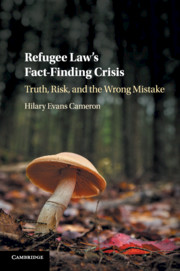Book contents
- Refugee Law’s Fact-Finding Crisis
- Refugee Law’s Fact-Finding Crisis
- Copyright page
- Dedication
- Contents
- Acknowledgements
- Introduction
- Part I
- Part II
- 2 Setting the Scene
- 3 The Wrong Mistake: Sending a Refugee Home
- 4 Resolving Doubt in the Claimant’s Favour
- 5 The Wrong Mistake: Accepting an Unfounded Claim
- 6 Resolving Doubt at the Claimant’s Expense
- 7 In the Hearing Room
- Part III
- Index
7 - In the Hearing Room
from Part II
Published online by Cambridge University Press: 20 April 2018
- Refugee Law’s Fact-Finding Crisis
- Refugee Law’s Fact-Finding Crisis
- Copyright page
- Dedication
- Contents
- Acknowledgements
- Introduction
- Part I
- Part II
- 2 Setting the Scene
- 3 The Wrong Mistake: Sending a Refugee Home
- 4 Resolving Doubt in the Claimant’s Favour
- 5 The Wrong Mistake: Accepting an Unfounded Claim
- 6 Resolving Doubt at the Claimant’s Expense
- 7 In the Hearing Room
- Part III
- Index
Summary
- Type
- Chapter
- Information
- Refugee Law's Fact-Finding CrisisTruth, Risk, and the Wrong Mistake, pp. 161 - 172Publisher: Cambridge University PressPrint publication year: 2018



